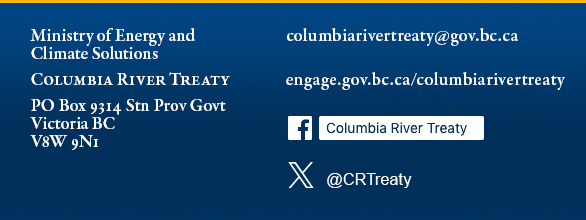Resources
Columbia River Treaty
Edition: September 2021
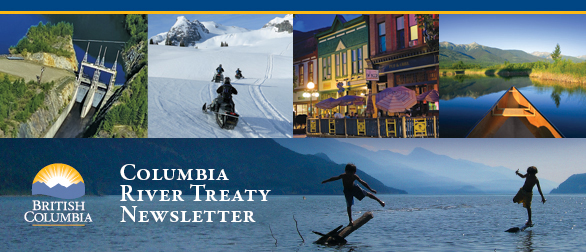

Consul General Sylvain Fabi and Minister Katrine Conroy speaking at the 2021 PNWER Annual Summit
PNWER Summit hosts Columbia River Treaty discussion
On Aug. 18, 2021, Canada’s Chief Negotiator for the Columbia River Treaty, Sylvain Fabi, and B.C.’s Minister Responsible for the Treaty, the Honourable Katrine Conroy, took part virtually in a Water Infrastructure & Policy session at the Pacific NorthWest Economic Region’s (PNWER) 30th Annual Summit. The pair spoke about modernizing the Treaty, common myths, and why it’s important for both countries to return to the negotiating table.
Fabi spoke first, emphasizing Canada’s desire to resume bi-lateral discussions.
“Throughout [the challenges of this past year], Canada has been ready to sit down and keep the negotiations going,” he said. “We are ready to have an agreement that provides a new flood-control regime and provides certainty. We’re ready to have a good discussion on the future of hydropower. We are ready to discuss ways that we can make a positive environmental difference. If we work together in good faith, we can accomplish all this.”

Logos of the Ktunaxa Nation, Syilx Okanagan Nation Alliance, and the Shuswap Nation Tribal Council; organizations representing the Ktunaxa, Syilx Okanagan and Secwépemc Nations in the Columbia River Treaty modernization process
Indigenous representation and reconciliation in the Treaty modernization process
The Columbia River Treaty (CRT), and the dams and reservoirs built within the territories of the Ktunaxa, Secwépemc, Syilx Okanagan and the Sinixt Nations, have impacted Aboriginal title and rights in the Basin. Over 1,000 km2 of productive ecosystem and habitat that had sustained the Indigenous Nations culturally, economically, and socially since time immemorial was destroyed.
Starting in 2011, the Province engaged in Indigenous and public consultation around CRT modernization, and in 2014 this resulted in the development of the B.C. Decision and Guiding Principles to negotiate a modernized Treaty. Importantly, these principles included the “consideration of Aboriginal rights.” The Province furthered its overall commitment to the UN Declaration on the Rights of Indigenous Peoples (UNDRIP) and working with Indigenous Nations by passing the 2019 Declaration on the Rights of Indigenous Peoples Act. This is the backdrop against which the the Ktunaxa, Secwépemc and Syilx Okanagan Nations (Indigenous Nations)[1], B.C. and Canada have led the way on engagement and partnership regarding CRT modernization.
[1] The Lakes Division of the Confederated Tribes of the Colville Reservation in Washington State, the successor tribe to the Sinixt in Canada, are being consulted on the modernization of the Columbia River Treaty by the U.S. Administration
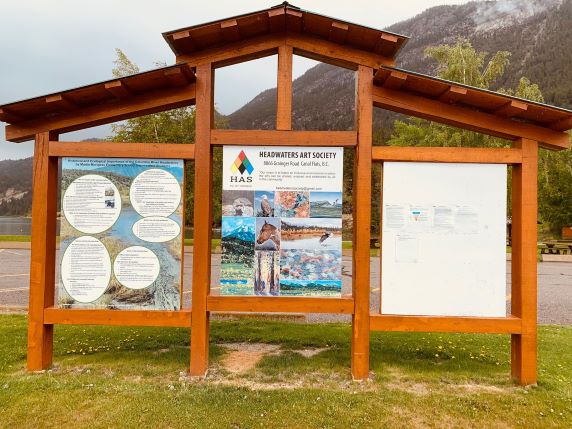
New interpretive sign at Columbia Lake, B.C.
Elementary students contribute to interpretive sign for Columbia River headwaters
This spring, a new interpretive sign was erected in Canal Flats, B.C. to highlight the significance of the Columbia River headwaters. The sign now stands in Tilley Memorial Park, at the south end of Columbia Lake, source of the Columbia River.
The project came together over the past three years, as students from Martin Morigeau Elementary School in Canal Flats worked with the Columbia Lake Stewardship Society (CLSS), Wildsight Invermere and local Indigenous partners.
“We began this project as a cross-curricular Social Studies and Science inquiry where students learned about Indigenous Peoples in the valley and their history of living near the Columbia River,” said Alyssan Gauthier, Principal of Martin Morigeau Elementary School. “Students learned about the importance of wetlands to our ecosystem, and plants and animals that are part of the river habitat.”
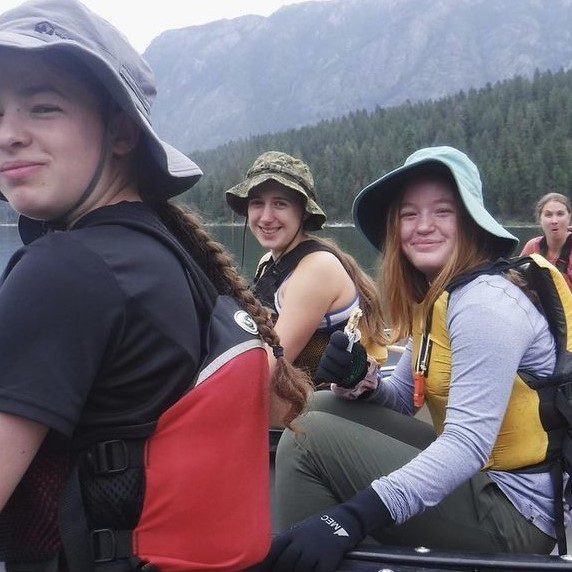
Aislinn Dressler, third from the left, and other Wildsight Columbia River Field School students paddling the Columbia River Watershed
Youth Spotlight: Aislinn Dressler
My Journey from the Columbia River Field School to Premier of the Interior Youth Parliament
My name is Aislinn Dressler, and I am a 17-year-old from Fernie, B.C. I applied to the Columbia River Field School (CRFS) in 2019 on a whim. A teacher had passed around a pamphlet at my high school and, while I wasn’t really sold, I went home that night and completed my application. When I hit send, I believed I had no shot at being a participant. With no camping, canoeing or backcountry experience, I wasn’t really the type of outdoorsy person that would go to this kind of adventurous field school.
But then, I got the email that I had been accepted and this long shot was a reality. I packed and I was off to meet 19 strangers and paddle a river! This school was full of hands-on learning, with comprehensive viewpoints surrounding the Columbia River Treaty, and I returned home impassioned to make a difference. Paddling through the Columbia River watershed opened my eyes to the interconnectedness of the ecosystem, and meeting so many experts exposed me to the different perspectives surrounding the Treaty.
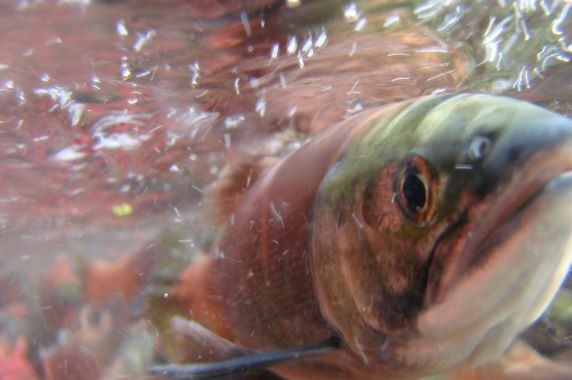
Salmon swimming in a river
Treaty Fact: How is salmon restoration being addressed in modernization of the Columbia River Treaty?
Exploring the feasibility of salmon returning to the Upper Columbia River is an important priority in the ongoing work to modernize the Columbia River Treaty. It is being addressed both within the Treaty and outside of it.
Though salmon passage up the river was blocked by the Grand Coulee Dam in 1939, well before the Treaty was in place, there are some factors related to salmon survival in the Upper Columbia that are directly impacted by Treaty operations, and so must be part of modernization discussions. Salmon reintroduction has been raised at the Canada-U.S. negotiating table, including at the 8th round of discussions in September 2019, where representatives of the Ktunaxa, Secwépemc and Syilx Okanagan Nations presented to the U.S. delegation on this topic.

